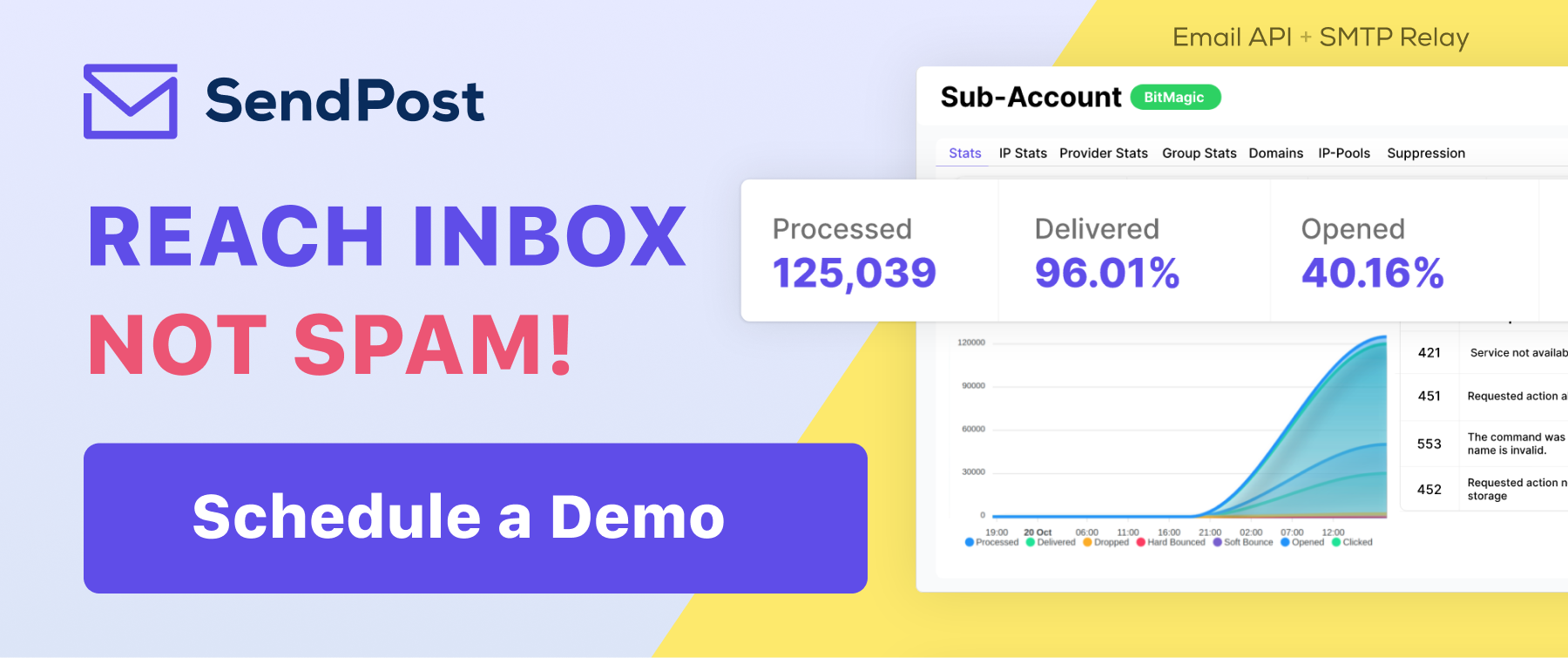
Email Deliverability for E-Commerce: Strategies for Successful Campaigns
Ad costs and influencer marketing prices in e-commerce have gone up a lot, leaving marketers confused. They want to find a way to reach customers effectively without spending too much money. Well, it turns out that email is the answer. Email marketing has been around for a long time and it has a special power. It can help you engage with your audience in a sustainable, profitable, and long-lasting way. But there's a problem: if your emails don't get delivered properly, all your efforts go to waste.
When your emails bounce back or get caught in spam filters, your marketing campaign becomes useless and costs you money. The important thing is to make sure your emails end up in the right inboxes instead of being marked as spam. This can make a huge difference in building a loyal customer base and avoiding wasted resources.
In this post, we'll talk about how you can ensure that your emails land in the potential customers' and customers' inboxes so they pay attention, engage and buy from you.
First we'll take a look at types of emails sent by eCommerce brands. Because that allows you to strategize the kind of content that will resonate most with your audience and how you can best avoid the dreaded spam folder.
Types of Emails Sent by eCommerce Companies
E-commerce brands typically send out a wide range of emails, from transactional and promotional to newsletters and cart abandonment reminders. Each type of email has its own unique function and deliverability considerations. For instance, transactional emails—like order confirmations and shipping notifications—have high open rates because they're expected by the customer. However, their non-promotional nature might lead to fewer spam complaints, bolstering overall deliverability.
On the other hand, promotional emails—offering discounts or showcasing new products—while more likely to drive direct sales, can also face higher scrutiny from spam filters and subscribers alike. Balancing the need for sales-driven communication with maintaining good deliverability health is a delicate dance every e-commerce marketer must learn to master.
- Transactional Emails: These are the 'need-to-know' emails, including order confirmations, shipping notifications, and account updates. They are essential in maintaining customer trust and often have a high open rate because customers anticipate their arrival. In terms of deliverability, they're typically safe from spam filters due to their non-promotional content, contributing to a healthier sender reputation.
- Welcome Emails: The first handshake in your digital relationship, a welcome email sets the tone for future communications. A friendly and clear welcome email can encourage engagement, laying a strong foundation for open rates down the line. It's also a golden opportunity to request your subscribers to whitelist your email address, further improving deliverability.
- Promotional Emails: The heart of most e-commerce marketing campaigns, promotional emails spotlight sales, special offers, and new products. They are direct drivers of revenue but can face a higher risk of landing in the spam folder due to their sales-oriented nature.
The trick here is balance - maintaining a healthy mix of promotional and non-promotional content can improve engagement and deliverability.
- Abandoned Cart Emails: These are your friendly nudges to customers who have left items in their online shopping cart. Crafted with a thoughtful tone and a sense of urgency, these emails can significantly boost your sales by reminding customers of their unfinished purchase. Deliverability for such emails is usually good, given they are highly targeted and relevant.
- Newsletters or Informational Emails: Regularly scheduled, these emails deliver useful content, company news, or industry insights to your subscribers. They help build a consistent relationship with your audience and position your brand as an authority in your niche. As they are often expected by subscribers and are less promotional, they have good deliverability rates. However, their value lies in providing genuinely interesting and valuable content that keeps your readers engaged.
Here's an engaging, informational email from a soda brand:
Why is Email Deliverability Important for eCommerce Brands?
Email deliverability isn't just a technical metric for e-commerce brands. It's a powerful lever of customer engagement, cost efficiency, and brand trust that can propel your e-commerce business to new heights.
- Customer engagement: e-commerce thrives on constant customer engagement. Unlike a physical store where customers can walk in and browse, e-commerce platforms need to bring their storefront to customers - and that's where emails shine. A well-delivered email can remind customers of your brand, showcase new products, or even nudge them to complete a purchase they might have forgotten. But none of this is possible if your emails aren't landing in the right inboxes.
- Rising cost of ads: The cost-effectiveness of email marketing is a big win for e-commerce businesses, especially in an environment where other marketing costs, such as ads or influencers, are on the rise. A well-managed email campaign delivers a high return on investment, making it a highly sustainable marketing channel. Implementing effective email marketing alongside strategic influencer marketing strategies can maximize ROI for spend. But again, the return depends on your emails actually reaching their intended recipients.
- Customer relationship: deliverability plays a vital role in the long-term health of your customer relationships. When your emails consistently reach their inboxes, customers start recognizing and trusting your brand more. In an online marketplace brimming with competition, this familiarity can be a significant advantage, leading to higher customer loyalty and repeat purchases.
With the strategies we'll explore in this blog, you'll be well on your way to mastering this crucial aspect of e-commerce marketing.
6 Strategies for Successful Campaigns by Ensuring High Email Deliverability
1. Build a Clean and Engaged Email List: A clean and engaged email list is essential for effective email deliverability. Start by regularly removing inactive or unengaged subscribers from your list. These are recipients who haven't opened or interacted with your emails in a long time.
Sending re-engagement campaigns is a great way to prompt them to either confirm their interest or unsubscribe. By doing this, you ensure that your list consists of people who genuinely want to receive your emails, improving the chances of higher engagement and deliverability.
Here's an example of a re-engagement email by an online coffee brand:
2. Implement Email Authentication: Email authentication protocols, such as SPF (Sender Policy Framework) and DKIM (DomainKeys Identified Mail), add an extra layer of security and credibility to your emails.
SPF allows you to specify the authorized servers that can send emails on behalf of your domain, while DKIM adds a digital signature to verify that the emails are indeed from your domain and haven't been tampered with. By implementing these protocols, you establish trust with email providers and reduce the likelihood of your emails being flagged as spam.
3. Craft Engaging and Relevant Content: Engaging content that resonates with your audience is key to improving deliverability. Segment your email list based on customer demographics, preferences, or past purchase behavior.
By sending targeted emails that align with each segment's interests, you increase the chances of your emails being opened, read, and acted upon.
Personalization techniques, such as using the recipient's name or referencing their past purchases, make your emails more relevant and captivating.
4. Test Emails for Compatibility: Ensuring that your emails appear correctly across different devices and email clients is crucial for optimal deliverability. Test your emails on popular devices and email platforms, including smartphones, tablets, and various web-based email services.
Pay attention to formatting, images, and links to ensure they are displayed correctly and function properly. By conducting thorough testing, you can catch any issues and make necessary adjustments to ensure a seamless experience for your recipients.
5. Monitor and Analyze Deliverability Metrics: Regularly monitoring deliverability metrics helps you gauge the success of your email campaigns and identify areas for improvement.
Keep an eye on metrics such as open rates, click-through rates, bounce rates, and spam complaints. Low open rates or high bounce rates may indicate deliverability problems that need attention.
Use email analytics tools provided by your email service provider or third-party solutions to analyze the data and gain insights into the effectiveness of your campaigns. Adjust your strategies based on the findings to continuously improve deliverability.
6. Choose the Right Software: If you're a large-scale sender, managing multiple sending domains and maintaining a good sending reputation can become challenging. That's when you need a tool like SendPost.SendPost provides businesses with the necessary tools, expertise, and support to ensure your emails reach your customers' inboxes on time, every time. Their sophisticated software alerts you in advance when your deliverability is at risk, offering proactive solutions. For businesses where email plays a critical role, SendPost can be a game-changing partner.
Conclusion
In the world of e-commerce, email deliverability plays a vital role in the success of your marketing campaigns.
By implementing strategies to ensure your emails reach the right inboxes and engage customers effectively, you can stand out amidst the noise and clutter. Remember, the journey to optimal deliverability is an ongoing process. Continuously adapt, test, and refine your email practices to stay ahead of the curve.
Embrace the power of email and its potential to foster meaningful connections with your audience. Let your emails be the gateway to unlocking lasting customer engagement and driving your e-commerce brand to new heights.



